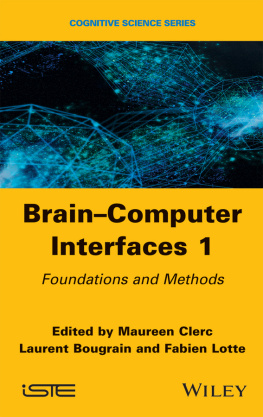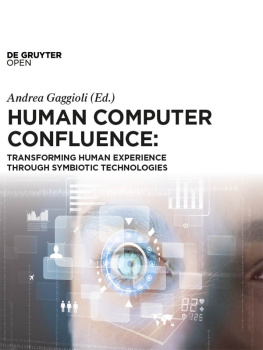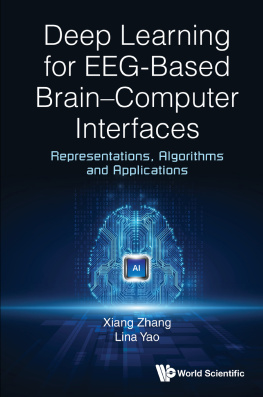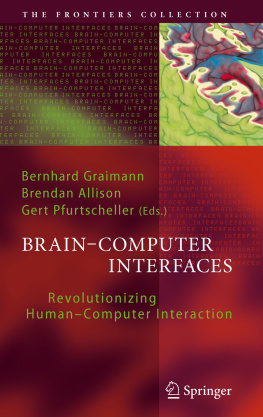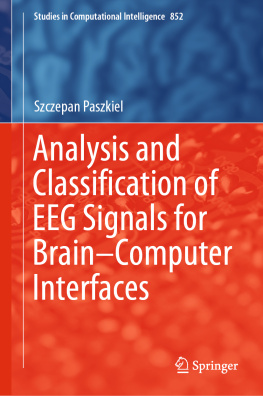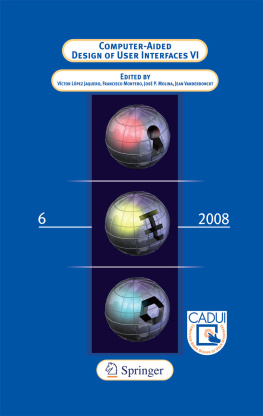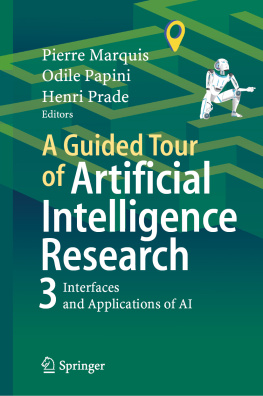Bougrain Laurent - Brain - computer interfaces n 2, Technology and applications
Here you can read online Bougrain Laurent - Brain - computer interfaces n 2, Technology and applications full text of the book (entire story) in english for free. Download pdf and epub, get meaning, cover and reviews about this ebook. City: Hoboken;New Jersey, year: 2016, publisher: John Wiley & Sons, Incorporated, genre: Computer. Description of the work, (preface) as well as reviews are available. Best literature library LitArk.com created for fans of good reading and offers a wide selection of genres:
Romance novel
Science fiction
Adventure
Detective
Science
History
Home and family
Prose
Art
Politics
Computer
Non-fiction
Religion
Business
Children
Humor
Choose a favorite category and find really read worthwhile books. Enjoy immersion in the world of imagination, feel the emotions of the characters or learn something new for yourself, make an fascinating discovery.
- Book:Brain - computer interfaces n 2, Technology and applications
- Author:
- Publisher:John Wiley & Sons, Incorporated
- Genre:
- Year:2016
- City:Hoboken;New Jersey
- Rating:4 / 5
- Favourites:Add to favourites
- Your mark:
- 80
- 1
- 2
- 3
- 4
- 5
Brain - computer interfaces n 2, Technology and applications: summary, description and annotation
We offer to read an annotation, description, summary or preface (depends on what the author of the book "Brain - computer interfaces n 2, Technology and applications" wrote himself). If you haven't found the necessary information about the book — write in the comments, we will try to find it.
Brain - computer interfaces n 2, Technology and applications — read online for free the complete book (whole text) full work
Below is the text of the book, divided by pages. System saving the place of the last page read, allows you to conveniently read the book "Brain - computer interfaces n 2, Technology and applications" online for free, without having to search again every time where you left off. Put a bookmark, and you can go to the page where you finished reading at any time.
Font size:
Interval:
Bookmark:
- 2 Medical Applications: Neuroprostheses and Neurorehabilitation
- 10 OpenViBE and Other BCI Software Platforms
- 16 Acceptance of Brainmachine Hybrids: How is Their Brain Perceived In Vivo?
- Introduction
- 2 Medical Applications: Neuroprostheses and Neurorehabilitation
- 3 Medical Applications of BCIs for Patient Communication
- 4 BrainTV: Revealing the Neural Bases of Human Cognition in Real Time
- 5 BCIs and Video Games: State of the Art with the OpenViBE2 Project
- 6 Analysis of Patient Need for BrainComputer Interfaces
- 7 Sensors: Theory and Innovation
- 8 Technical Requirements for High-quality EEG Acquisition
- 9 Practical Guide to Performing an EEG Experiment
- 10 OpenViBE and Other BCI Software Platforms
- 11 Illustration of Electrophysiological Phenomena with OpenViBE
- 12 Classification of Brain Signals with OpenViBE
- 13 OpenViBE Illustration of a P300 Virtual Keyboard
- 14 Recreational Applications of OpenViBE: Brain Invaders and Use-the-Force
- 16 Acceptance of Brainmachine Hybrids: How is Their Brain Perceived In Vivo?
- 17 Conclusion and Perspectives

Series Editor
Maureen Clerc
Edited by
Maureen Clerc
Laurent Bougrain
Fabien Lotte

First published 2016 in Great Britain and the United States by ISTE Ltd and John Wiley & Sons, Inc.
Apart from any fair dealing for the purposes of research or private study, or criticism or review, as permitted under the Copyright, Designs and Patents Act 1988, this publication may only be reproduced, stored or transmitted, in any form or by any means, with the prior permission in writing of the publishers, or in the case of reprographic reproduction in accordance with the terms and licenses issued by the CLA. Enquiries concerning reproduction outside these terms should be sent to the publishers at the undermentioned address:
ISTE Ltd
27-37 St Georges Road
London SW19 4EU
UK
www.iste.co.uk
John Wiley & Sons, Inc.
111 River Street
Hoboken, NJ 07030
USA
www.wiley.com
ISTE Ltd 2016
The rights of Maureen Clerc, Laurent Bougrain and Fabien Lotte to be identified as the authors of this work have been asserted by them in accordance with the Copyright, Designs and Patents Act 1988.
Library of Congress Control Number: 2016945318
British Library Cataloguing-in-Publication Data
A CIP record for this book is available from the British Library
ISBN 978-1-84821-963-2
A BrainComputer Interface (BCI) records brain signals, translates them into commands that operate a variety of devices, and provides feedback to the user about how intentions are transformed into actions. These three essential components, forming a closed-loop system, define the core components of a BCI. Their natural target population has traditionally been people with motor disabilities that have lost control of their body but have preserved cognitive functions, and BCIs have been intended to act as alternative assistive devices for them. However, in recent years the scope of a BCI has widened to include restoration or rehabilitation of motor and even cognitive functions for patients after some kind of central nervous system injury, brain state monitoring for healthy subjects, and new tools for studying human brain functions.
An anecdotal, even fringe, field of research at the confines with science fiction when it appeared, BCIs have grown over the last 40 years from early prototypes in a handful of locations to more than 3,000 research labs and nearly 150 companies working in BCI-related areas nowadays. The complexity of todays BCI systems, which are moving beyond constrained laboratory conditions, calls for truly multidisciplinary efforts spanning clinical research to computer science and humancomputer interfaces, from neuroscience to biomedical and neuroengineering, from rehabilitation to robotics and virtual reality, and from human psychology to material and electrical engineering.
This wide range of fields that contribute to BCI makes it difficult, if not impossible, to have a unified view covering all the facets of this fascinating scientific and translational enterprise. Thus, a certain bias is always present and openly acknowledged in our research. This book is no exception. It is edited by signal processing and machine learning specialists. Yet, aiming to become a reference for the French-speaking research community, it gathers a collective body of expertise from all the fields involved in BCI research and practice. We consider this challenge that the editors have successfully tackled, as the book covers state-of-the-art research and results in a way that all other communities can relate to. Furthermore, the curious layperson I hope you are if you want to live long with a healthy brain! can also profit from a significant number of chapters that do not require any specific background.
The book is organized into seven parts, distributed between two volumes.
Following on from the first volume (Foundations and Methods), this second volume (Technology and Applications) clearly exposes the field of BCI from the standpoint of end users (mainly people with physical disabilities) and practitioners. concludes the second volume of this reference book by addressing key societal issues regarding ethics and acceptability, which should concern any informed citizen from the researcher to the experimental subject, from the clinician to the end user and from the philosopher to the policy maker.
BrainComputer Interfaces by Clerc, Bougrain and Lotte is the first BCI book for and by the French-speaking community. Here, it is also translated in English as it has important lessons for all BCI researchers and practitioners worldwide. I am certain that this book will appeal to each of them as it has done to me. Enjoy it.
Jos DEL R. MILLN
Geneva
Switzerland
May 2016
A BrainComputer Interface (BCI) is a system that translates a users brain activity into messages or commands for an interactive application. BCIs represent a relatively recent technology that is experiencing a rapid growth. The objective of this introductory chapter is to briefly present an overview of the history of BCIs, the technology behind them, the terms and classifications used to describe them and their possible applications. The books content is presented, and a reading guide is provided so that you, the reader, can easily find and use whatever you are searching for in this book.
The idea of being able to control a device through mere thought is not new. In the scientific world, this idea was proposed by Jacques Vidal in 1973 in an article entitled Toward Direct BrainComputer Communications [VID 73]. In this article, the Belgian scientist, who had studied in Paris and taught at the University of California, Los Angeles, describes the hardware architecture and the processing he sought to implement in order to produce a BCI through electroencephalographic signals. In 1971, Eberhard Fetz had already shown that it was possible to train a monkey to voluntarily control cortical motor activity by providing visual information according to discharge rate [FET 71]. These two references show that since that time, BCIs could be implemented in the form of invasive or non-invasive brain activity measurements, that is, measurements of brain activity at the neural or scalp levels. For a more comprehensive history of BCIs, the reader may refer to the following articles: [LEB 06, VAA 09].
Font size:
Interval:
Bookmark:
Similar books «Brain - computer interfaces n 2, Technology and applications»
Look at similar books to Brain - computer interfaces n 2, Technology and applications. We have selected literature similar in name and meaning in the hope of providing readers with more options to find new, interesting, not yet read works.
Discussion, reviews of the book Brain - computer interfaces n 2, Technology and applications and just readers' own opinions. Leave your comments, write what you think about the work, its meaning or the main characters. Specify what exactly you liked and what you didn't like, and why you think so.


